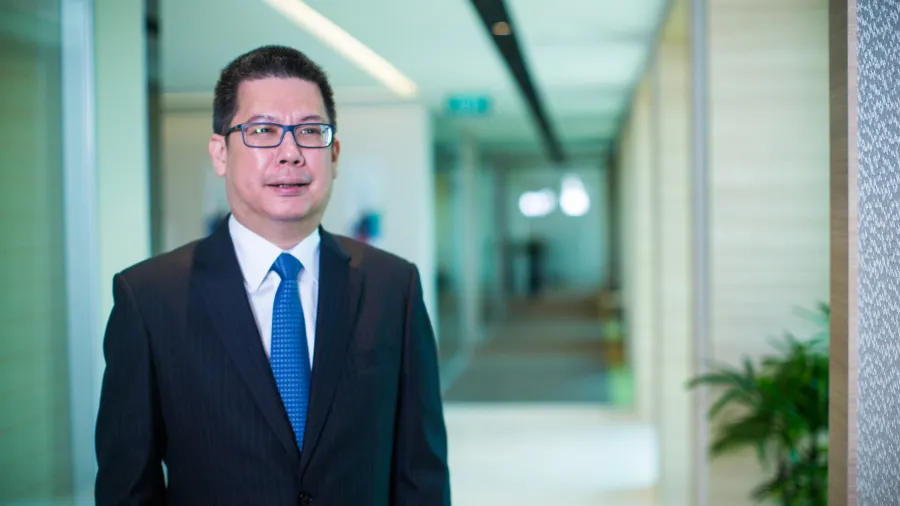
Singapore needs to prepare for the future of work, says Deloitte exec
Manufacturers must reskill talent, refresh employment brand to attract and retain talent
Richard Loi has built a 30-year career in public accounting serving public and private clients from diverse industries. As an Audit partner based in Singapore, he also serves as the Southeast Asia (SEA) Leader for Deloitte Private, for which he serves clients in Singapore and in the region.
He also leads the Family Enterprise Consulting practice in Southeast Asia, helping family businesses to flourish across generations. In this role, he works with families in the region to help them articulate their vision and values, facilitate family meetings, and align all family members in the creation of family constitution/agreement for the future. He also advises on family governance structures and succession planning.
Using his deep experience as the audit partner of complex global engagements, Richard has advised listed companies, multinationals, and local privately-owned companies in relation to their IPO on the Singapore Exchange, and has led teams in special investigation and system audits.
As a judge in the Singapore Business Review’s Made in Singapore Awards & Designed in Singapore Awards, Richard spoke about his thoughts on how Singapore’s manufacturing sector grew despite the pandemic, and how manufacturers can attract and retain talent by reskilling employees and refreshing their brand.
Can you explain your role as the Private Leader of Southeast Asia at Deloitte?
As the Southeast Asia Leader for Deloitte Private, I help high-net-worth individuals, family businesses and private enterprises in the region to accelerate their business growth and preserve their wealth whilst protecting and extending their legacy.
I also lead Deloitte's Family Enterprise Consulting practice in Southeast Asia, helping family businesses thrive across generations, both from a business and family perspective. I work closely with them to articulate their vision and values, facilitate family meetings, bringing alignment through the creation of family constitution/agreement amongst family members for the future. I also advise family businesses on family governance structure and succession planning.
I am based in Singapore where I am also an Audit Partner with more than 30 years of public accounting experience serving public and private clients from various industries. As an Audit Partner, I specialise in advising listed companies, multinationals and local privately-owned companies on initial public offering (IPO) on the Singapore Exchange. I have worked on complex global engagements and led teams in special investigation and system audits.
What are the challenges that Singapore manufacturers experienced during the pandemic? How has the current supply chain disruption affected the operations of manufacturers in Singapore?
During the pandemic, some businesses running on a just-in-time inventory system were left without availability of new inventory because access to their suppliers no longer existed. Logistics were disrupted by a shortage of containers or ships. There was also a substantive increase in costs of freighting goods by sea, air, rail, or road, along with the increased lead and delivery times.
The need for supply chain visibility was also highlighted by the pandemic as importers are required to have visibility across their entire supply chain to ensure that there are no components or finished goods that are manufactured under slavery or forced labour. For an importer, this is a huge challenge and the consequences of non-compliance can be catastrophic for the company and its market share.
However, Singapore’s resilient trade performance suggests that it has not been significantly affected by these disruptions. During the height of the pandemic, Singapore’s manufacturing sector grew 2.5%, bolstered by strong semiconductor and biomedical production activities. The growth in cloud usage for remote working and home entertainment like video streaming and gaming helped support the semiconductor industry, whilst the biomedical sector benefited from the increasing demand for instruments and test kits, as well as critical supplies such as masks and medical equipment.
How are Singaporean manufacturers adapting to the changes brought by the pandemic? What are the trends and strategies that you have noticed in the past 12 months that manufacturers are leveraging?
When the pandemic hit, Singapore companies, including manufacturers, had to rethink their strategies and accelerate the pace of technology in their business. Many moved their businesses online to deal with the disruption brought by the pandemic to their brick-and-mortar operations. The government also provided strong support measures to help companies adopt a digital strategy to improve operations and generate new revenue.
As the business operations slowly return to normal, where should Singaporean manufacturers focus to become more profitable and sustainable in the future?
Competing in the new market demands business agility. At Deloitte, our 2022 manufacturing industry outlook identifies five important trends for manufacturing playbooks in the year ahead.
1. Workforce shortage: Preparing for the future of work could be critical to resolving current talent scarcity
Record numbers of unfilled jobs are likely to limit higher productivity and growth in 2022, and last year, Deloitte estimated a shortfall of 2.1 million skilled jobs by 2030. To attract and retain talent, manufacturers should pair strategies such as reskilling with a recasting of their employment brand. Shrinking the industry’s public perception gap by making manufacturing jobs a more desirable entry point could be critical to meeting hiring needs in 2022. Engagement with a wider talent ecosystem of partners to reach diverse, skilled talent pools can help offset the recent wave of retirements and voluntary exits.
Manufacturing executives may also need to balance goals for retention, culture, and innovation. As flexible work is taking root in offices, manufacturers should explore ways to add flexibility across their organisation in order to attract and retain workers.
2. Supply chain instability: Manufacturers are remaking supply chains for advantage beyond the next disruption
Supply chain challenges are acute and still unfolding. Manufacturers are facing near-continuous disruptions globally that add costs and test abilities to adapt. Purchasing manager reports continue to reveal systemwide complications from high demand, rising costs of raw materials and freight, and slow deliveries. Transportation challenges are likely to continue in 2022, including driver shortages in trucking and congestion at container ports. As demand outpaces supply, higher costs are more likely to be passed on to customers. Supply chain strategies in 2022 are expected to be multipronged. Digital supply networks and data analytics can be powerful enablers for more flexible, multitiered responses to disruptions.
3. Smart factory initiatives: Acceleration in digital technology adoption could bring operational efficiencies to scale
Manufacturers looking to capture growth and protect long-term profitability should embrace digital capabilities from corporate functions to the factory floor. Smart factories, including greenfield and brownfield investments for many manufacturers, are viewed as one of the keys to driving competitiveness. More organisations are making progress and seeing results from more connected, reliable, efficient, and predictive processes at the plant. Emerging and evolving use cases can continue to scale up from isolated in-house technology projects to full production lines or factories, given the right mix of vision and execution.
Investment in robots, cobots, and artificial intelligence can continue to transform operations. Foundational technologies such as cloud computing enable computational power, visibility, scale, and speed.
Singapore, with a keen focus on technology, is well-positioned to strengthen its manufacturing sector, by boosting productivity for lower-end activities and growing higher-value processes. It currently has a strong base in advanced manufacturing with industries such as precision engineering and biomedical sciences. Singapore is also stepping up its efforts, committing to developing cutting-edge capabilities, such as robotics, to become a "more digital and more resilient” advanced manufacturing base in Asia for the world.
4. Cybersecurity: Rising threats are leading the industry to new levels of preparedness
High-profile cyberattacks across industries and governments in the past year have elevated cybersecurity as a risk management essential for most executives and boards. Surging threats during the pandemic added to business risk for manufacturers in the crosshairs for ransomware. An expanding attack surface from the connection of operational technology (OT), information technology (IT), and external networks requires more controls. Legacy systems and technology were not purpose-fit for today’s sophisticated network challenges. Now, remote work vulnerabilities leave manufacturers even more susceptible to breaches.
Manufacturers should look not only at their cyber defences but also at the resiliency of their business in the event of a cyberattack. Cybercriminals can cause harm beyond intellectual property theft and financial losses, using malware that now ties in AI and cryptocurrencies. They can also shut down operations and disrupt entire supplier networks, compromising safety as well as productivity. A patchwork of regulations for different industries could be consolidated under the current administration’s “whole-of-nation” approach to protect critical infrastructure. The potential for additional oversight is likely to prompt more industrials to rethink preparedness for crisis response.
5. ESG investment: Manufacturers are likely to bring more resources and rigor to advancing sustainability
The fast rise of environmental, social, and governance (ESG) factors is redefining and elevating sustainability in manufacturing as never before. Cost of capital can be tied to ratings on ESG, making it a priority for organisational financial health and competitiveness. Expectations for reporting on diversity, equity, and inclusion metrics in manufacturing will likely continue to rise. Board diversity, whilst progressing slowly, is also showing some momentum. To attract talent and appeal to workforce expectations, most manufacturers are making ESG efforts more visible.
Depending on a manufacturer’s end markets, environmental accountability is increasingly a focus. To develop and deliver against net-zero or carbon-neutral goals, more organisations are dedicating or redesigning sustainability roles and initiatives and quantifying efforts and results around energy consumption. And the fast-evolving ESG landscape may require close monitoring in 2022 for manufacturers. Many organisations are complying voluntarily within a complex network of reporting regulations, ratings, and disclosure frameworks. But regulators globally are also moving toward requiring disclosure for more non-financial metrics. Proactive approaches may help manufacturers stay ahead of the change and create competitive advantage.
What key criteria did you consider in selecting the winners of the Made in Singapore Awards and Designed in Singapore Awards?
The pandemic has reiterated the importance of innovation and digital transformation for survival and success. Winners of the Made in Singapore Awards and Designed in Singapore Awards stood out for their efforts in embracing innovation and digital transformation that positioned them as industry leaders.



![SBR 5 Lorem Ipsum News 2 [8 May]](https://cmg-qa.s3.ap-southeast-1.amazonaws.com/s3fs-public/styles/exclusive_featured_article/public/2025-05/a_hand_pointing_to_a_futuristic_technology_5b87c9d0e3_3.png.webp?itok=M3Hf-9XR)
![SBR 4 Lorem Ipsum [8 May Top Stories]](https://cmg-qa.s3.ap-southeast-1.amazonaws.com/s3fs-public/styles/exclusive_featured_article/public/2025-05/a_hand_pointing_to_a_futuristic_technology_5b87c9d0e3_2.png.webp?itok=2m5Wl0MX)


![Exclusive three SBR 12 Lorem Ipsum [8 May]](https://cmg-qa.s3.ap-southeast-1.amazonaws.com/s3fs-public/styles/exclusive_featured_article/public/2025-05/a_hand_pointing_to_a_futuristic_technology_5b87c9d0e3_11.png.webp?itok=8kn_UIfA)
![SBR 3 Lorem Ipsum [ Exclusive 2]](https://cmg-qa.s3.ap-southeast-1.amazonaws.com/s3fs-public/styles/exclusive_featured_article/public/2025-05/a_hand_pointing_to_a_futuristic_technology_5b87c9d0e3_1.png.webp?itok=YCyjLegJ)
![SBR 2 Lorem Ipsum [8 May]](https://cmg-qa.s3.ap-southeast-1.amazonaws.com/s3fs-public/styles/exclusive_featured_article/public/2025-05/a_hand_pointing_to_a_futuristic_technology_5b87c9d0e3_0.png.webp?itok=_cKD-29o)

![Video [Event News]](https://cmg-qa.s3.ap-southeast-1.amazonaws.com/s3fs-public/styles/event_news_featured_article/public/2025-05/screenshot-2025-05-08-at-4.58.53-pm_0.png.webp?itok=Kud35sMs)
![Event News SBR 9 Lorem Ipsum [8 may]](https://cmg-qa.s3.ap-southeast-1.amazonaws.com/s3fs-public/styles/event_news_thumbnail/public/2025-05/a_hand_pointing_to_a_futuristic_technology_5b87c9d0e3_8.png.webp?itok=DTh_dbYp)
![Event News SBR 9 Lorem Ipsum [8 May]](https://cmg-qa.s3.ap-southeast-1.amazonaws.com/s3fs-public/styles/event_news_thumbnail/public/2025-05/a_hand_pointing_to_a_futuristic_technology_5b87c9d0e3_7.png.webp?itok=vzDAzb6V)
![Event News SBR 8 Lorem Ipsum [8 May]](https://cmg-qa.s3.ap-southeast-1.amazonaws.com/s3fs-public/styles/event_news_thumbnail/public/2025-05/a_hand_pointing_to_a_futuristic_technology_5b87c9d0e3_6.png.webp?itok=jvHFc4P6)
![Video [Event News]](https://cmg-qa.s3.ap-southeast-1.amazonaws.com/s3fs-public/styles/video_thumbnail/public/2025-05/screenshot-2025-05-08-at-4.58.53-pm_0.png.webp?itok=yZnI0YBb)
![Video 1 SBR [8 May]](https://cmg-qa.s3.ap-southeast-1.amazonaws.com/s3fs-public/styles/video_thumbnail/public/2025-05/screenshot-2025-05-08-at-4.58.53-pm.png.webp?itok=9AAeRz_k)

 Advertise
Advertise

